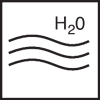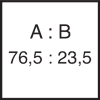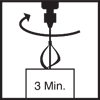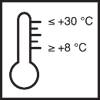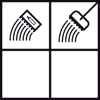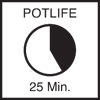Article No. 632111
Water-based, pigmented levelling layer and base coat

Product specifications
Component A
Component B
Mixture
The stated values represent typical product characteristics and are not to be construed as binding product specifications.
Field of application
- Primer in Remmers water vapour diffusion (WDD) systems
- Levelling layer and base coat in Remmers water vapour diffusion (WDD) systems
- Primer and base coat in the systems
Remmers Deck OS 8 WD and Deck OS 8 WD-LE - Primer in DIBt approved systems for common rooms (general building inspectorate approval Z-156.605-1414)
Properties
- Highly fillable
- Ideal base for uniform flake coatings
- Water vapour diffusion capable
- Freeze/thaw resistant
- System certification for rear moisture penetration
- Contains no plasticisers, nonylphenols or alkylphenols
- Physiologically harmless once fully cured
-
Preparation
-
Substrate requirements
The substrate must be firm, dimensionally stable, capable of bearing loads and free of loose constituents, dust, oil, grease, rubber marks and other substances that could interfere with adhesion.
The tensile strength of the surface of the substrate must be at least 1.5 N/mm² on average (smallest individual value of at least 1.0 N/mm²), and the compressive strength must be at least 25 N/mm².
When used in the OS 8 system, the tensile strength of the substrate must be at least 2.0 N/mm² on average (smallest individual value of at least 1.5 N/mm²).
Test report available on bond behaviour in conjunction with rear moisture penetration according to DIN EN 13578 in the OS 8 system.
Substrates must have reached their moisture balance and must also be protected against moisture penetration from the reverse side, including during use.
Concrete max. 6 m% moisture Cement screed max. 6 m% moisture Other substrates suitable for coating must be primed with Epoxy BS 2000.
The adhesive pull strength of the surface after priming must be at least 1.5 N/mm² on average (smallest single value min. 1.0 N/mm²), compressive strength at least 25 N/mm².
Refer to the current Technical Data Sheet for detailed information on the single products.
-
Preparations
Prepare the substrate by suitable means, e.g. steel shot blasting, so that it meets the specifications listed above.
Broken-out or missing areas in the substrate should be filled flush with the surface using Remmers RM systems (RM = Repair Mortar) or Remmers EP mortars.
-
-
Preparation
-
Combination container
Add the entire quantity of the hardener (component B) to the base compound (component A).
Mix thoroughly with a slow-speed electric mixer
(approx. 300 - 400 rpm).Pour the mixture into a separate container and mix again thoroughly.
Mix for at least 3 minutes.
Insufficient mixing is indicated by streaks forming.
Add up to 10% by mass of water, depending on the binder, and mix again.
-
Application
-
Application requirements
Temperature of the material, air and substrate: from min. +8 °C to max. +30 °C
-
The times given are reduced at higher temperatures and increased at lower temperatures, in particular in combination with high humidity.
-
Working tools / cleaning
-
Notched trowel, smoothing trowel, looped roller, paintbrush, epoxy roller and mixer
-
More detailed information can be found in the Remmers Tool Programme.
Clean tools, equipment and any splashed material immediately with water while still fresh.
Take suitable protective and waste disposal measures when cleaning.
-
Storage / shelf life
-
If stored unopened in its original container in a cool, dry place and protected against frost, the product will keep for at least 9 months.
-
Usage
-
See application examples
-
-
Application examples
-
Application Degree of filling with Selectmix SBL Binder application rate [kg/m²] Filler application rate [kg/m²] Toothed blade Unfilled coating - min. 0.40 - no. 22 Filled coating 1 : 0.5 min. 0.60 +
10% watermin. 0.30 smoothing trowel Filled coating 1 : 1.0 min. 0.70 +
10% watermin. 0.70 no. 7 Filled coating 1 : 1.5 min. 1.10 +
10% watermin. 1.65 no. 55 -
Priming
Apply the mixed resin generously to the surface. Distribute with a suitable tool, e.g. rubber blade, and work into the substrate with an epoxy roller so that pores in the surface of the substrate are completely filled.
It may be necessary to apply several layers.
Approx. 0.15 - 0.25 kg/m² binder (depending on the substrate)
-
Levelling layer/scratch coat
Once the material has been filled up to 1:1.5 parts by weight, apply to the prepared surface, spread using a suitable notched spreader, and go over again with a looped roller if necessary.
Use Selectmix SBL as the filler.
The application rate depends on the condition of the substrate.
Either coat with Epoxy BS 4000 or seal with Epoxy BS 3000 M or Epoxy BS 3000 SG.
(see table)
-
Coating
Once the material has been filled up to 1:1.5 parts by weight, apply to the prepared surface, spread using a suitable notched spreader, and go over again with a looped roller if necessary.
Use Selectmix SBL as the filler.
The application rate depends on the condition of the substrate.
Seal with Epoxy BS 3000 M or Epoxy BS 3000 SG.
(see table)
-
Base layer for blinded coatings
Once the material has been filled up to 1:1.5 parts by weight, apply to the prepared surface, spread using a suitable notched spreader, and go over again with a looped roller if necessary.
Scatter an excess of quartz sand or Colorid/sediment flakes over the base layer while it is still wet.
For use in OS 8 systems, see the applicable test certificates.
Use Selectmix SBL as the filler.
Remove any loose, excess material after hardening.
Then, apply the fixing agent or sealant as per the system specifications.
(see table)
-
-
General information
-
Unless otherwise specified, all of the values and application rates given above have been determined under laboratory conditions (20 °C) using standard colours. Slight deviations from these values may arise if the product is worked with on site.
Primers must always be applied so that all pores are filled; it may therefore be necessary to increase the application rate or to apply a second coat.
When coating continuous surfaces, only use materials with the same batch number as slight differences in colour, gloss and texture may occur.
Shades of colour with low hiding power (e.g. yellow, red or orange) tend to have a translucent effect on the subsequently applied sealant. In such cases, a colour-coordinated construction, e.g. light grey, is necessary.
The maximum degree of filling for levelling layers may vary depending on the colour. If necessary, check special colours to determine their suitability for filling.
The coating system has a lightly textured surface that is characteristic of this type of system.
In order to achieve even surfaces, appropriate allowances for roughness depth must be taken into consideration.
Epoxy resins are generally not colourfast when exposed to UV light or weather.
Further notes on working, system construction and maintenance of the listed products can be found in the latest Technical Data Sheets and the Remmers system recommendations.
Observe the corresponding test certificate for OS 8 systems.
For the installation of systems that are subject to approval, the directions contained in the relevant approval must be observed.
-
-
Disposal instructions
-
Larger quantities of leftover product should be disposed of in the original containers in accordance with the applicable regulations. Completely empty, clean containers should be recycled. Do not dispose of together with household waste. Do not allow to enter the sewage system. Do not empty into drains.
-
-
Safety / regulations
-
For professional users only!
For further information on the safety aspects of transporting, storing and handling the product and on disposal and environmental matters, please see the current Safety Data Sheet and the brochure entitled "Epoxy Resins in the Construction Industry and the Environment", issued by Deutsche Bauchemie e.V. (3rd edition 2022).
-



